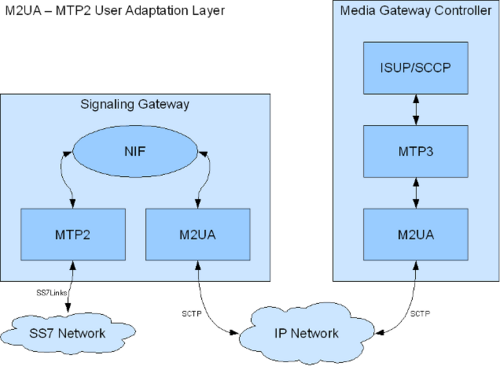M2UA
From TBwiki
(Difference between revisions)
(Added links to newer versions) |
m (Needs revising edit) |
||
| Line 1: | Line 1: | ||
| − | The M2UA (Message Transfer Part 2 User Adaptation Layer) is used to interface [[MTP2 Layer|MTP2]] of the signaling gateway to the [[MTP3 Layer|MTP3]] of a media gateway controller. M2UA can also be seen as way to extend | + | The M2UA (Message Transfer Part 2 User Adaptation Layer) is used to interface the [[MTP2 Layer|MTP2]] of the signaling gateway to the [[MTP3 Layer|MTP3]] of a media gateway controller. M2UA can also be seen as way to extend an MTP2 link. An M2UA link is always bound to an MTP2 link. |
| − | + | The following diagram illustrates the setup using M2UA: | |
| Line 8: | Line 8: | ||
| − | + | The M2UA layer can interface with either a NIF or an MTP3 layer; therefore, M2UA has two modes of operation. Furthermore, Toolpack can configure M2UA in both modes. | |
| Line 30: | Line 30: | ||
[[category:Glossary]] | [[category:Glossary]] | ||
| − | |||
[[Category:Revise on Major]] | [[Category:Revise on Major]] | ||
Revision as of 14:18, 16 March 2018
The M2UA (Message Transfer Part 2 User Adaptation Layer) is used to interface the MTP2 of the signaling gateway to the MTP3 of a media gateway controller. M2UA can also be seen as way to extend an MTP2 link. An M2UA link is always bound to an MTP2 link.
The following diagram illustrates the setup using M2UA:
The M2UA layer can interface with either a NIF or an MTP3 layer; therefore, M2UA has two modes of operation. Furthermore, Toolpack can configure M2UA in both modes.
TelcoBridges and M2UA
TelcoBridges supports M2UA as part of its SIGTRAN implementation.
Configuration
References
- Article at Protocols.com
- RFC 3331 Signaling System 7 (SS7) Message Transfer Part 2 (MTP2) - User Adaptation Layer
